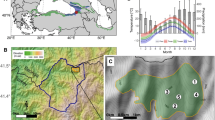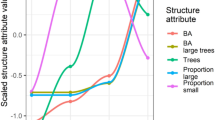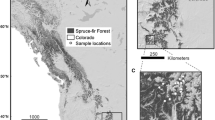Abstract
We quantified rates, sizes, and spatial properties of prevailing disturbance regimes in five tropical rain forest landscapes on a substrate-age gradient in Hawaii. By integrating measurements from airborne LiDAR with field studies and statistical modeling, we show that the structure and dynamics of these forests respond to processes that change during the development of ecosystems. On young substrates of 0.3 ky where forests are in primary succession and are limited by N, mean canopy height was 13 m and height decreases more than 1 m occurred in small, isolated events (power-law exponent = 1.69 ± 0.02, n = 61 gaps ha−1). The proportion of the landscape affected by disturbance increased on high-fertility intermediate-aged substrates of 5–65 ky and canopies were heterogeneous. Frequencies of height decreases more than 1 m were n = 14, 18, and 30 gaps ha−1 corresponding to power-law exponents of 2.188 ± 0.02, 2.220 ± 0.03, and 1.982 ± 0.02 on substrates of 5, 20, and 65 ky. There was a substantial difference between forests on a 150 ky substrate and sites of 5–65 ky; trees on the older substrate formed patchworks of stunted cloud-forest and stands of taller-stature trees. The frequency of recent disturbance events more than 1 m was n = 48 gaps ha−1, corresponding to a power-law exponent of 1.638 ± 0.01. Across the substrate-age gradient, the proportion of each landscape that decreased in height by more than 1 m was 0.16, 0.40, 0.41, 0.36, and 0.17, respectively. These findings demonstrate that substrate age and processes associated with ecosystem development can mediate the rates, sizes, and spatial characteristics of disturbance regimes on forested landscapes, and point toward the necessity of large-area samples to obtain robust estimates of natural dynamics.





Similar content being viewed by others
References
Asner GP, Hughes RF, Varga TA, Knapp DE, Kennedy-Bowdoin T. 2009. Environmental and biotic controls over aboveground biomass throughout a tropical rain forest. Ecosystems 12:261–78.
Asner GP, Knapp DE, Kennedy-Bowdoin T, Jones MO, Martin RE, Boardman JW, Field CB. 2007. Carnegie airborne observatory: in-flight fusion of hyperspectral imaging and waveform light detection and ranging (wLiDAR) for three-dimensional studies of ecosystems. J Appl Remote Sens 1:1–21.
Asner GP, Powell GVN, Mascaro J, Knapp DE, Clark JK, Jacobson J, Kennedy-Bowdoin T, Balaji A, Paez-Acosta G, Victoria E, Secada L, Valqui M. 2010. High-resolution forest carbon stocks and emissions in the Amazon. Proc Natl Acad Sci USA Early Ed 1–5.
Asner GP, Vitousek PM. 2005. Remote analysis of biological invasion and biogeochemical change. Proc Natl Acad Sci USA 102:4383–6.
Brokaw NVL. 1982. The definition of treefall gap and its effect on measures of forest dynamics. Biotropica 14:158–60.
Chadwick OA, Derry LA, Vitousek PM, Huebert BJ, Hedin LO. 1999. Changing sources of nutrients during four million years of ecosystem development. Nature 397:491–7.
Chadwick OA, Kelly EF, Hotchkiss SC, Vitousek PM. 2007. Precontact vegetation and soil nutrient status in the shadow of Kohala Volcano, Hawaii. Geomorphology 89:70–83.
Chambers JQ, Robinson IN, Hurtt GC, Marra DM, Higuchi N. 2009. Lack of intermediate-scale disturbance data prevents robust extrapolation of plot-level tree mortality rates for old-growth tropical forests. Ecol Lett 12:E22–5.
Cressie NAC. 1993. Statistics for spatial data. New York: Wiley.
Crews TE, Kitayama K, Fownes JH, Riley RH, Herbert DA, Mueller-Dombois D, Vitousek PM. 1995. Changes in soil phosphorus fractions and ecosystem dynamics across a long chronosequence in Hawaii. Ecology 76:1407–24.
Fisher JI, Hurtt GC, Thomas RQ, Chambers JQ. 2008. Clustered disturbances lead to bias in large-scale estimates based on forest sample plots. Ecol Lett 11:554–63.
Gelfand AE, Ghosh SK. 1998. Model choice: a minimum posterior predictive loss approach. Biometrika 85:1–11.
Harrington RA, Fownes JH, Vitousek PM. 2001. Production and resource use efficiencies in N- and P-limited tropical forests: a comparison of responses to long-term fertilization. Ecosystems 4:646–57.
Hart P. 2010. Tree growth and age in an ancient Hawaiian wet forest: vegetation dynamics at two spatial scales. J Trop Ecol 26:1–11.
Hedin LO, Vitousek PM, Matson PA. 2003. Nutrient losses over four million years of tropical forest development. Ecology 84:2231–55.
Herbert DA, Fownes JH. 1999. Forest productivity and efficiency of resource use across a chronosequence of tropical montane soils. Ecosystems 2:242–54.
Hobbie SE, Vitousek PM. 2000. Nutrient limitation of decomposition in Hawaiian forests. Ecology 81:1867–77.
Hotchkiss S. 1998. Quaternary vegetation and climate of Hawai’i. Minneapolis: University of Minnesota.
Kellner JR, Asner GP. 2009. Convergent structural responses of tropical forests to diverse disturbance regimes. Ecol Lett 12:887–897.
Kellner JR, Clark DB, Hubbell SP. 2009. Pervasive canopy dynamics produce short-term stability in a tropical rain forest landscape. Ecol Lett 12:155–64.
Körner C. 2003. Slow in, rapid out—carbon flux studies and Kyoto targets. Science 300:1242–3.
Lefsky MA, Cohen WB, Parker GG, Harding DJ. 2002. Lidar remote sensing for ecosystem studies. Bioscience 52:19–30.
Lloyd J, Gloor EU, Lewis SL. 2009. Are the dynamics of tropical forests dominated by large and rare disturbance events? Ecol Lett 12:E19–21.
Mueller-Dombois D. 1986. Perspectives for an etiology of stand-level dieback. Ann Rev Ecol Syst 17:221–43.
Pebesma EJ. 2004. Multivariable geostatistics in S: the gstat package. Comput Geosci 30:683–91.
Porder S, Asner GP, Vitousek PM. 2005. Ground-based and remotely sensed nutrient availability across a tropical landscape. Proc Natl Acad Sci USA 102:10909–12.
Saatchi S, Harris NL, Brown S, Lefsky M, Mitchard ETA, Salas W, Zutta BR, Buermann W, Lewis SL, Hagen S, Petrova S, White L, Silman M, Morel A. 2011. Benchmark map of forest carbon stocks in tropical regions across three continents. Proc Natl Acad Sci USA 108(24):9899–904.
Team RDC. 2011. R: A language and environment for statistical computing. Vienna: R Foundation for Statistical Computing.
ter Steege H. 2006. Continental-scale patterns of canopy tree composition and function across Amazonia. Nature 443:444–7.
Torn MS, Trumbore SE, Chadwick OA, Vitousek PM, Hendricks DM. 1997. Mineral control of soil organic carbon storage and turnover. Nature 389:170–3.
van Schaik CP, Miramanto E. 1985. Spatial variation in the structure and litterfall of a Sumatran rain forest. Biotropica 17:196–205.
Vitousek PM. 2004. Nutrient cycling and limitation: Hawaii as a model system. Princeton (NJ): Princeton University Press.
Vitousek PM, Asner GP, Chadwick OA, Hotchkiss S. 2009. Landscape-level variation in forest structure and biogeochemistry across a substrate age gradient in Hawaii. Ecology 90:3074–86.
Vitousek PM, Chadwick OA, Matson PA, Allison S, Derry L, Kettley L, Luers A, Meckind E, Monastra V, Porder S. 2003. Erosion and the rejuvenation of weathering-derived nutrient supply in an old tropical landscape. Ecosystems 6:762–72.
Vitousek PM, Turner DR, Kitayama K. 1995. Foliar nutrients during long-term soil development in Hawaiian montane rain forest. Ecology 76:712–20.
Vitousek PM, Walker LR, Whiteaker LD, Mueller-Dombois D, Matson PA. 1987. Biological invasion by Myrica faya alters ecosystem development in Hawaii. Science 238:802–4.
Walker TW, Syers JK. 1976. The fate of phosphorus during pedogenesis. Geoderma 15:1–19.
Acknowledgments
This study was funded by NSF grant DEB-0715593, the Gordon and Betty Moore Foundation and the Carnegie Institution. The Carnegie Airborne Observatory is made possible by the W.M. Keck Foundation and William Hearst III.
Author information
Authors and Affiliations
Corresponding author
Additional information
Author contributions
JRK, GPA, PMV, MAT, SH and OAC designed research, performed research, analyzed data and wrote the paper.
Electronic supplementary material
Below is the link to the electronic supplementary material.
10021_2011_9472_MOESM3_ESM.tif
Figure S1. Distinguishing recent disturbance events using simulated LiDAR imagery. A and B are digital canopy models from two points in time. Panel C is a model of canopy-height change obtained by subtracting panel B from panel A. For a given magnitude height class, h, contiguous pixels with vegetation height decrease ≥ h m are recent disturbance events, shown here for h = 1, 5, 10 and 15 m. Note how events of small magnitude are large in area and contain events of larger magnitude height change. Small offsets in boundaries are for clarity. (TIFF 9408 kb)
10021_2011_9472_MOESM4_ESM.tif
Figure S2. Example spherical semivariograms, showing the effects of varying the asymptotic semivariance (A), the range (B), the nugget (C), or all three parameters (D). (TIFF 11726 kb)
Rights and permissions
About this article
Cite this article
Kellner, J.R., Asner, G.P., Vitousek, P.M. et al. Dependence of Forest Structure and Dynamics on Substrate Age and Ecosystem Development. Ecosystems 14, 1156–1167 (2011). https://doi.org/10.1007/s10021-011-9472-4
Received:
Accepted:
Published:
Issue Date:
DOI: https://doi.org/10.1007/s10021-011-9472-4




